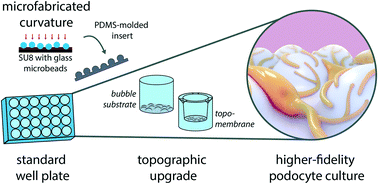Curvature facilitates podocyte culture in a biomimetic platform†
Abstract
Most kidney diseases begin with abnormalities in glomerular podocytes, motivating the need for podocyte models to study pathophysiological mechanisms and new treatment options. However, podocytes cultured in vitro face a limited ability to maintain appreciable extents of differentiation hallmarks, raising concerns over the relevance of study results. Many key properties such as nephrin expression and morphology reach plateaus that are far from the in vivo levels. Here, we demonstrate that a biomimetic topography, consisting of microhemispheres arrayed over the cell culture substrate, promotes podocyte differentiation in vitro. We define new methods for fabricating microscale curvature on various substrates, including a thin porous membrane. By growing podocytes on our topographic substrates, we found that these biophysical cues augmented nephrin gene expression, supported full-size nephrin protein expression, encouraged structural arrangement of F-actin and nephrin within the cell, and promoted process formation and even interdigitation compared to the flat substrates. Furthermore, the topography facilitated nephrin localization on curved structures while nuclei lay in the valleys between them. The improved differentiation was also evidenced by tracking barrier function to albumin over time using our custom topomembranes. Overall, our work presents accessible methods for incorporating microcurvature on various common substrates, and demonstrates the importance of biophysical stimulation in supporting higher-fidelity podocyte cultivation in vitro.



 Please wait while we load your content...
Please wait while we load your content...